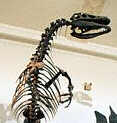SJ Attractions: Dinosaur Discoveries
 In the summer of 1858, fossil hobbyist William Parker Foulke was vacationing in Haddonfield, when he heard that twenty years earlier, workers had found gigantic bones in a local marl pit. Foulke spent the rest of the summer with a group of hired men, digging. Eventually he found what he was hoping for: bones!! The diggers uncovered the bones of an animal larger than an elephant, with structural features of both a lizard and a bird--a "Hadrosaurus foulkii."
In the summer of 1858, fossil hobbyist William Parker Foulke was vacationing in Haddonfield, when he heard that twenty years earlier, workers had found gigantic bones in a local marl pit. Foulke spent the rest of the summer with a group of hired men, digging. Eventually he found what he was hoping for: bones!! The diggers uncovered the bones of an animal larger than an elephant, with structural features of both a lizard and a bird--a "Hadrosaurus foulkii." This discovery was the first almost complete skeleton of a dinosaur; an event that would rock the scientific world and forever change our view of natural history. It also became the first mounted dinosaur skeleton displayed anywhere in the world in 1868!
Hadrosaurus foulkii became the official State dinosaur of New Jersey in 1991 after years of hard work by a teacher, Joyce Berry, and her fourth grade classes at Strawbridge Elementary School in Haddon Township. As a result of their efforts, New Jersey has a truly unique symbol of its prehistoric past.
The historic discovery site, a heavily-wooded ravine running parallel to Maple Avenue in Haddonfield, is marked with a small commemorative stone and a tiny landscaped park. Just beyond the stone the ground drops away into the steep ravine where the bones of Hadrosaurus foulkii were originally excavated on the eve of the Civil War. Visitors can still climb down crude paths into the 30-foot, vine-entangled chasm to stand in an almost primordial quiet at the actual marl pit where the imagination of all mankind was exploded outward to embrace the stunning fact that our planet was once ruled by fantastically large, bizarrely shaped reptilian creatures.
A narrow stream--now called "Hadrosaurus Run" -- wends its way through the ravine to empty into Cooper River, the central waterway of an adjacent county park system. As Hadrosaurus Run snakes its way out toward that park land, it also exposes bluish-gray marl deposits where ancient seashells can still be found.
During the Cretaceous period, southern New Jersey at what is now Haddonfield was under about 100 feet of sea water. The actual coast line was located roughly along the region of what is now Philadelphia. Sea bed sediments ultimately became the marl deposits that are now a common geological feature throughout the southern half of the state.
The same marl is rich in fossils of ancient sea life as well as land creatures, such as Hadrosaurus, that sank to the bottom to be quickly covered and naturally preserved.
If you're interested in seeing the actual bones that were discovered, Hadrosaurus is still featured as the keynote specimen in the Philadelphia Academy of Natural Sciences' extensive dinosaur exhibit.
The Academy still keeps some of the original Hadrosaurus bones on display in the same type of wooden boxes Leidy used to store them in the 1860s. Leidy officially named the animal Hadrosaurus foulkii in honor of both the town of Haddonfield and the discoverer, William Foulke.
Some information collected from, and for more information about this exciting New Jersey attraction, check out the Hadrosaurus foulkii website.
advertisement

Author: C. Cohen
Archives
A TALE OF THREE WEDDINGS
Timber Creek’s Leary heads to Illinois
The Berlin Cemetery
A Southern Mansion
Fire on the Morro Castle
Pine Barrens Fire of 1936
The Legacy of Hezekiah Bradley Smith
The Powhatan Renape Indians
The `Park-In` Movie Theatre
Glassboro: A History
New Jersey Natives: The Lenni-Lenape
Burlington County Prison Museum
Parvin State Park
Haines Mill
John Henry `Pop` Lloyd
More...






